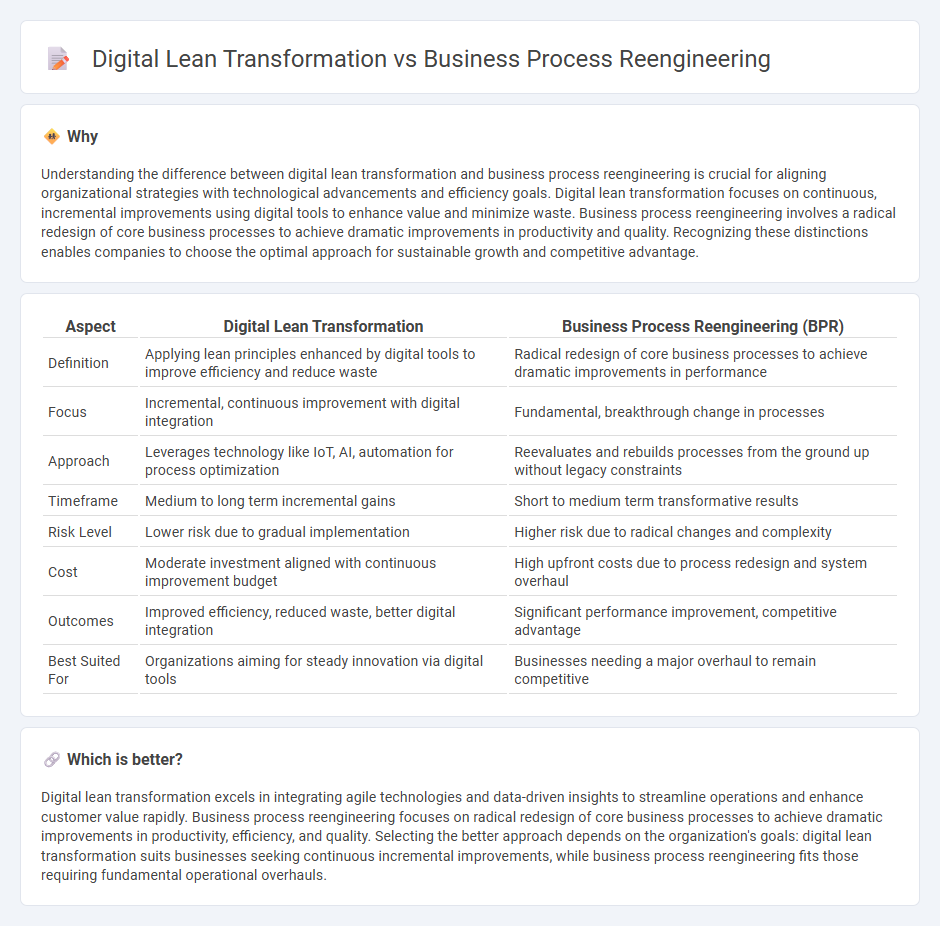
Digital Lean Transformation focuses on integrating digital technologies to streamline workflows, reduce waste, and enhance operational efficiency, whereas Business Process Reengineering involves fundamentally redesigning core business processes to achieve dramatic improvements in performance metrics such as cost, quality, and speed. Digital Lean Transformation leverages tools like automation, AI, and real-time data analytics to enable continuous improvement, while Business Process Reengineering often requires a top-down approach for radical change. Discover how these methodologies can redefine your organization's growth and agility.
Why it is important
Understanding the difference between digital lean transformation and business process reengineering is crucial for aligning organizational strategies with technological advancements and efficiency goals. Digital lean transformation focuses on continuous, incremental improvements using digital tools to enhance value and minimize waste. Business process reengineering involves a radical redesign of core business processes to achieve dramatic improvements in productivity and quality. Recognizing these distinctions enables companies to choose the optimal approach for sustainable growth and competitive advantage.
Comparison Table
| Aspect | Digital Lean Transformation | Business Process Reengineering (BPR) |
|---|---|---|
| Definition | Applying lean principles enhanced by digital tools to improve efficiency and reduce waste | Radical redesign of core business processes to achieve dramatic improvements in performance |
| Focus | Incremental, continuous improvement with digital integration | Fundamental, breakthrough change in processes |
| Approach | Leverages technology like IoT, AI, automation for process optimization | Reevaluates and rebuilds processes from the ground up without legacy constraints |
| Timeframe | Medium to long term incremental gains | Short to medium term transformative results |
| Risk Level | Lower risk due to gradual implementation | Higher risk due to radical changes and complexity |
| Cost | Moderate investment aligned with continuous improvement budget | High upfront costs due to process redesign and system overhaul |
| Outcomes | Improved efficiency, reduced waste, better digital integration | Significant performance improvement, competitive advantage |
| Best Suited For | Organizations aiming for steady innovation via digital tools | Businesses needing a major overhaul to remain competitive |
Which is better?
Digital lean transformation excels in integrating agile technologies and data-driven insights to streamline operations and enhance customer value rapidly. Business process reengineering focuses on radical redesign of core business processes to achieve dramatic improvements in productivity, efficiency, and quality. Selecting the better approach depends on the organization's goals: digital lean transformation suits businesses seeking continuous incremental improvements, while business process reengineering fits those requiring fundamental operational overhauls.
Connection
Digital lean transformation and business process reengineering are connected through their shared goal of optimizing operational efficiency by eliminating waste and redesigning workflows using digital technologies. Business process reengineering focuses on fundamentally rethinking and redesigning processes, while digital lean transformation integrates lean principles with advanced digital tools like automation, AI, and data analytics to enhance process agility and performance. Together, they enable organizations to achieve significant cost savings, faster cycle times, and improved customer value.
Key Terms
Process Optimization
Business process reengineering (BPR) involves radical redesign of core business processes to achieve dramatic improvements in productivity and efficiency, often resulting in complete structural changes. Digital lean transformation integrates lean principles with advanced digital technologies to streamline workflows, reduce waste, and enhance process optimization through continuous incremental improvements. Explore how leveraging these methodologies can revolutionize your organization's operational efficiency and performance.
Value Stream Mapping
Business process reengineering (BPR) fundamentally redesigns core business processes to achieve dramatic improvements in productivity and efficiency, often using Value Stream Mapping (VSM) to identify waste and bottlenecks. In contrast, digital lean transformation integrates advanced digital technologies with lean principles, leveraging VSM to enhance real-time process visibility and continuous improvement. Explore how combining these methodologies with Value Stream Mapping can accelerate operational excellence and drive sustainable business growth.
Digital Enablement
Business process reengineering (BPR) centers on fundamentally redesigning workflows to achieve dramatic improvements in performance metrics such as cost, quality, service, and speed, whereas digital lean transformation integrates lean principles with digital technologies to optimize efficiency and eliminate waste through continuous improvement. Digital enablement in BPR involves deploying advanced tools like robotic process automation (RPA) and artificial intelligence (AI) to automate and radically transform processes, while in digital lean transformation, it emphasizes real-time data analytics, IoT integration, and cloud computing to streamline operations and enhance decision-making agility. Explore how leveraging digital enablement strategies can drive sustainable business innovation and competitive advantage.
Source and External Links
A complete guide to business process reengineering (BPR) - Moxo - Business process reengineering is a structured approach that involves identifying inefficient processes, setting clear objectives, mapping current workflows, designing new processes, assessing technology needs, implementing changes, and continuously monitoring and refining results for organizational transformation.
Business Process Reengineering - Bain & Company - BPR is the radical redesign of business processes to achieve dramatic improvements in productivity, cycle times, quality, and satisfaction by refocusing on customer needs, simplifying work, leveraging technology, reorganizing into cross-functional teams, and rethinking organizational roles and third-party partnerships.
Business process re-engineering - Wikipedia - BPR is a management strategy focused on analyzing and redesigning organizational workflows and processes to achieve significant gains in efficiency, cost reduction, and customer satisfaction, often by questioning existing assumptions and realigning processes with strategic goals and modern technology.
 dowidth.com
dowidth.com